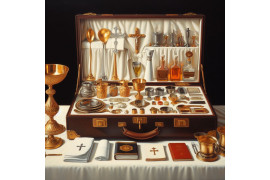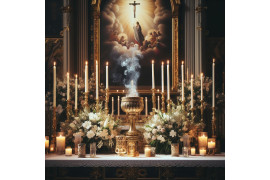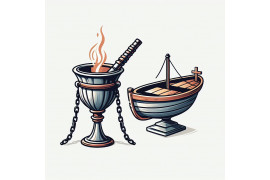The chalice holds significant importance in Christianity, serving as a symbol of profound spiritual meaning. With origins rooted in ancient times, the chalice has been an integral part of Christian worship for centuries. Drawing inspiration from the Jewish tradition of using a cup for ceremonial purposes, early Christians adopted the chalice as a powerful representation of Christ's blood during communion. Through this sacred vessel, believers commemorate and partake in the divine sacrifice made by Jesus on the cross.
Throughout history, the design and materials used for chalices have evolved to reflect cultural influences and artistic expressions. From simple vessels to ornate works of art, these sacred cups continue to hold immense reverence within Christian rituals and traditions. Understanding the historical significance of the chalice not only deepens our appreciation for its role in worship but also provides insight into the rich tapestry of Christian faith.
Role of the Chalice in the Last Supper and Holy Communion
During the Last Supper, Jesus used a chalice to institute the sacrament of communion. This sacred act holds immense significance for Christians around the world, as it symbolizes their connection to Christ and his sacrifice for humanity's salvation.
The chalice represents Christ's bloodshed for our redemption. In Christian theology, Jesus' blood is believed to have cleansed believers from sin and offered them eternal life. The chalice serves as a powerful visual reminder of this profound act of love and grace.
In Holy Communion, also known as the Eucharist or Lord's Supper, believers partake of bread and wine that symbolize Christ's body and blood. The bread represents his body broken on the cross, while the wine signifies his bloodshed for forgiveness. These elements are often served from a chalice during church services.
The chalice plays a central role in this sacred ritual. It holds the consecrated wine that is shared among worshipers as they remember Jesus' sacrifice and express their faith in him. As Christians drink from the chalice, they believe they are spiritually nourished by participating in Christ's redemptive work.
According to gospel accounts, during the Last Supper, Jesus took bread, blessed it, broke it, and gave it to his disciples saying, "This is my body." He then took a cup filled with wine, blessed it again, and said, "This is my blood." By offering these elements to his followers, he established an enduring tradition that continues to be observed by Christians today.
The farewell discourse given by Jesus during this final meal with his disciples further emphasizes the importance of communion. He encouraged them to continue partaking in this act as a way of remembering him until he returns again. The chalice serves as a tangible representation of this ongoing remembrance and connection with Christ.
In addition to its symbolic significance, the chalice also holds practical importance during Holy Communion. Its design typically includes a stem and a base, ensuring stability and ease of handling. The shape of the cup allows for easy pouring and distribution of the wine to worshipers.
Symbolism of the Chalice in Christian Tradition
The chalice holds a significant place in Christian tradition, symbolizing various aspects of faith and spirituality. Let's explore the symbolism associated with the chalice:
Vessel of Divine Grace and Blessings
In Christianity, the chalice is regarded as a vessel that holds divine grace and blessings. It represents the presence of God's love and mercy, which believers receive during Holy Communion. The chalice serves as a tangible reminder of God's abundant grace poured out for humanity.
Spiritual Nourishment and Sustenance
The chalice also symbolizes spiritual nourishment and sustenance for Christians. Just as physical nourishment is essential for our bodies, spiritual nourishment is vital for our souls. Through partaking in the Eucharist, Christians believe they are receiving spiritual sustenance from Christ Himself, strengthening their faith and deepening their connection with God.
Abundance Flowing through Faith
The shape of the chalice itself carries symbolic meaning. With its wide bowl and narrow stem, it represents abundance flowing through faith. The broad bowl signifies the vastness of God's love and blessings, while the slender stem represents the pathway to receiving those blessings—faith. It reminds Christians that when they have faith in God, His abundance flows into their lives.
Unity among Believers
Another important symbolism associated with the chalice is unity among believers. During communion services, Christians come together to partake of the bread and wine from a shared chalice. This act signifies their unity as members of one body—the body of Christ—and their common participation in His sacrifice on the cross. The chalice becomes a powerful symbol of community and fellowship among Christians.
Throughout history, artists have depicted these symbolic meanings through various representations of the chalice in religious art and iconography. These visual depictions often emphasize its sacred significance within Christian tradition.
The Holy Grail and its Connection to the Chalice
Legends surrounding the Holy Grail have captivated imaginations throughout history. This mystical object is believed by some to be the same cup used by Jesus at the Last Supper, making it synonymous with the chalice. The connection between the Holy Grail and Christianity has inspired numerous works of literature, art, and film.
The Holy Grail is often portrayed as possessing mystical powers or being sought after on quests, like King Arthur's knights searching for it. These tales have added an air of mystery and intrigue to the concept of the Holy Grail, turning it into a symbol of divine power and spiritual enlightenment.
In Christian tradition, the Last Supper holds great significance, as it was during this meal that Jesus instituted the sacrament of Communion. According to the Gospels in the New Testament, Jesus took a cup filled with wine and said, "This is my blood of the covenant, which is poured out for many" (Mark 14:24). This act established a new covenant between God and humanity through Jesus' sacrifice on the cross.
The chalice used during this momentous event became a sacred vessel representing this covenant. It symbolizes Christ's bloodshed for humanity's redemption and serves as a reminder of his sacrifice. In Christian rituals such as Mass or Eucharist, wine is consecrated in a chalice to represent Christ's blood.
The association between the Holy Grail and chalices extends beyond its connection to Jesus' crucifixion. Some legends suggest that Joseph of Arimathea used this very cup to collect drops of Christ's blood at his crucifixion. This adds another layer of symbolism to the chalice as a vessel intimately connected to Jesus' passion.
Throughout history, various interpretations have emerged regarding what exactly happened to this sacred relic after Jesus' death. Some believe it was hidden away or taken to different locations, while others claim it was lost or destroyed. These differing accounts have only fueled the fascination and allure surrounding the Holy Grail.
The quest for the Holy Grail has been a recurring theme in literature, art, and film. It has inspired countless stories of heroic knights embarking on perilous journeys to find this elusive object. These tales often explore themes of faith, redemption, and the pursuit of spiritual enlightenment.
Neopaganism and Alternative Interpretations of the Chalice
In neopagan traditions like Wicca, the chalice holds a significant place in rituals and ceremonies. It is considered a sacred tool that represents the feminine divine and the element of water. This alternative interpretation of the chalice differs from its traditional Christian symbolism.
Some alternative interpretations view the chalice as more than just a physical cup. It is seen as a symbol of spiritual transformation or enlightenment. Just as water can cleanse and purify, the chalice represents the potential for inner growth and personal development.
The chalice can also be seen as a metaphor for an individual's inner journey towards self-discovery and connection with the divine. In this context, it becomes a vessel that holds one's aspirations, hopes, and desires for spiritual fulfillment. The act of drinking from the chalice during rituals symbolizes partaking in this transformative journey.
These alternative interpretations draw inspiration from various spiritual traditions around the world. For example, in ancient Greek mythology, there is a tale of Dionysus using a magical cup known as "the Holy Grail" to bestow wisdom upon those who drank from it. This story resonates with some neopagans who see their own ritual chalices as vessels of divine wisdom.
In addition to Wicca, other neopagan traditions also incorporate the use of a ritual chalice in their practices. One such tradition is Druidry, where they emphasize reverence for nature and connection to ancestral spirits. The chalice represents not only water but also serves as a reminder of our interconnectedness with all living beings.
It's important to note that these alternative interpretations are not limited to neopaganism alone. Within Christianity itself, there are different depictions and understandings of the chalice beyond its association with Jesus' Last Supper.
For instance, some Christian mystics interpret the chalice as a symbol of the soul's receptivity to God's grace. They view it as a vessel that can be filled with divine love and spiritual nourishment. This interpretation aligns with the idea of the chalice as a metaphor for inner transformation and connection with the divine.
Exploring the Poisoned Chalice Metaphor in Christianity
The phrase "poisoned chalice" is a metaphor often used to describe an opportunity or position that initially appears desirable, but ultimately brings unexpected harm or difficulties. This metaphor has its origins in biblical scripture, specifically referring to Judas Iscariot's betrayal of Jesus after drinking from the same cup during the Last Supper.
In Christian teachings and literature, the poisoned chalice serves as a cautionary reminder of how appearances can be deceiving and highlights the consequences of deceit and treachery. It symbolizes the idea that even something seemingly good or blessed can turn out to be harmful or detrimental.
The story of Judas Iscariot drinking from the same cup as Jesus during the Last Supper is a powerful example of this metaphor. The Last Supper was a significant event in Christianity, representing Christ's sacrifice for humanity and establishing the sacrament of Communion. In this context, the chalice represents both a blessing and a burden.
Biblical Origins: Judas Iscariot's Betrayal
According to biblical accounts, during the Last Supper, Jesus shared bread and wine with his disciples, instructing them to remember him through these elements. However, it was at this sacred moment that Judas Iscariot betrayed Jesus by identifying him to his captors for thirty pieces of silver.
Judas' act of betrayal after drinking from the same cup as Jesus became synonymous with accepting a poisoned chalice. The chalice itself symbolizes not only Christ's sacrifice but also Judas' deceitful actions and their devastating consequences.
Symbolism and Lessons Learned
The poisoned chalice metaphor teaches Christians important lessons about discernment, trustworthiness, and integrity. It reminds believers to exercise caution when presented with seemingly favorable opportunities or positions because they may hide dangers or negative consequences.
This metaphor illustrates that what may appear to be a blessing can turn out to be harmful if not approached with wisdom and discernment. It serves as a reminder that actions have consequences and that deceit and treachery ultimately lead to ruin.
Application in Christian Teachings and Literature
The poisoned chalice metaphor is frequently used in Christian teachings, sermons, and literature to convey moral lessons. It highlights the importance of honesty, loyalty, and faithfulness while warning against the dangers of deception and betrayal.
By examining the story of Judas Iscariot's betrayal, Christians are encouraged to reflect on their own actions and choices. They are reminded to strive for integrity, authenticity, and transparency in their relationships with others.
The Profound Meaning of the Chalice in Christian Faith
In conclusion, the chalice holds a profound significance in Christianity, representing both the Last Supper and Holy Communion. It serves as a symbol of Christ's sacrifice and his bloodshed for the redemption of humanity. Through the chalice, Christians partake in communion to remember and reenact this sacred act. Beyond its religious context, the chalice has also captured imaginations through its association with the Holy Grail, an elusive object that has inspired countless legends and quests.
As you delve deeper into the symbolism of the chalice, you will discover alternative interpretations from Neopaganism and other spiritual practices. Exploring metaphors like the "poisoned chalice" can provide further insights into how this symbol resonates within Christian teachings. Whether you approach it from a religious or secular perspective, contemplating the meaning behind this vessel can enrich your understanding of faith and spirituality.
FAQs
What is the origin of using a chalice in Christian rituals?
The use of a chalice in Christian rituals traces back to Jesus' Last Supper with his disciples. During this meal, he took bread and wine, giving them new significance as symbols of his body and blood. This act forms the foundation for Holy Communion or Eucharist practiced by many Christian denominations today.
Is there only one true Holy Grail?
The concept of a single true Holy Grail is largely rooted in medieval legends and Arthurian tales. However, different interpretations exist regarding its nature - whether it is an actual physical object or a symbolic representation. Ultimately, belief in one true Holy Grail varies among individuals and traditions.
Can anyone partake in communion?
Communion practices differ among various Christian denominations. Some churches may require baptism or membership to participate fully in communion rites. However, others have more inclusive practices that allow all believers to partake regardless of their denominational affiliation.
What does the term "poisoned chalice" mean in Christianity?
The phrase "poisoned chalice" is a metaphor often used to describe a situation or opportunity that appears desirable but may bring unforeseen negative consequences. In Christianity, it can be seen as a reminder of the dangers of temptation and the need for discernment in making choices aligned with one's faith.
How can I incorporate the symbolism of the chalice into my own spiritual practice?
If you are drawn to the symbolism of the chalice, you can explore incorporating it into your personal spiritual practice. This could involve using a chalice as part of meditation or prayer rituals, reflecting on its meaning during times of contemplation, or studying further about its significance in Christian traditions. Ultimately, how you incorporate this symbol will depend on your own beliefs and practices.



